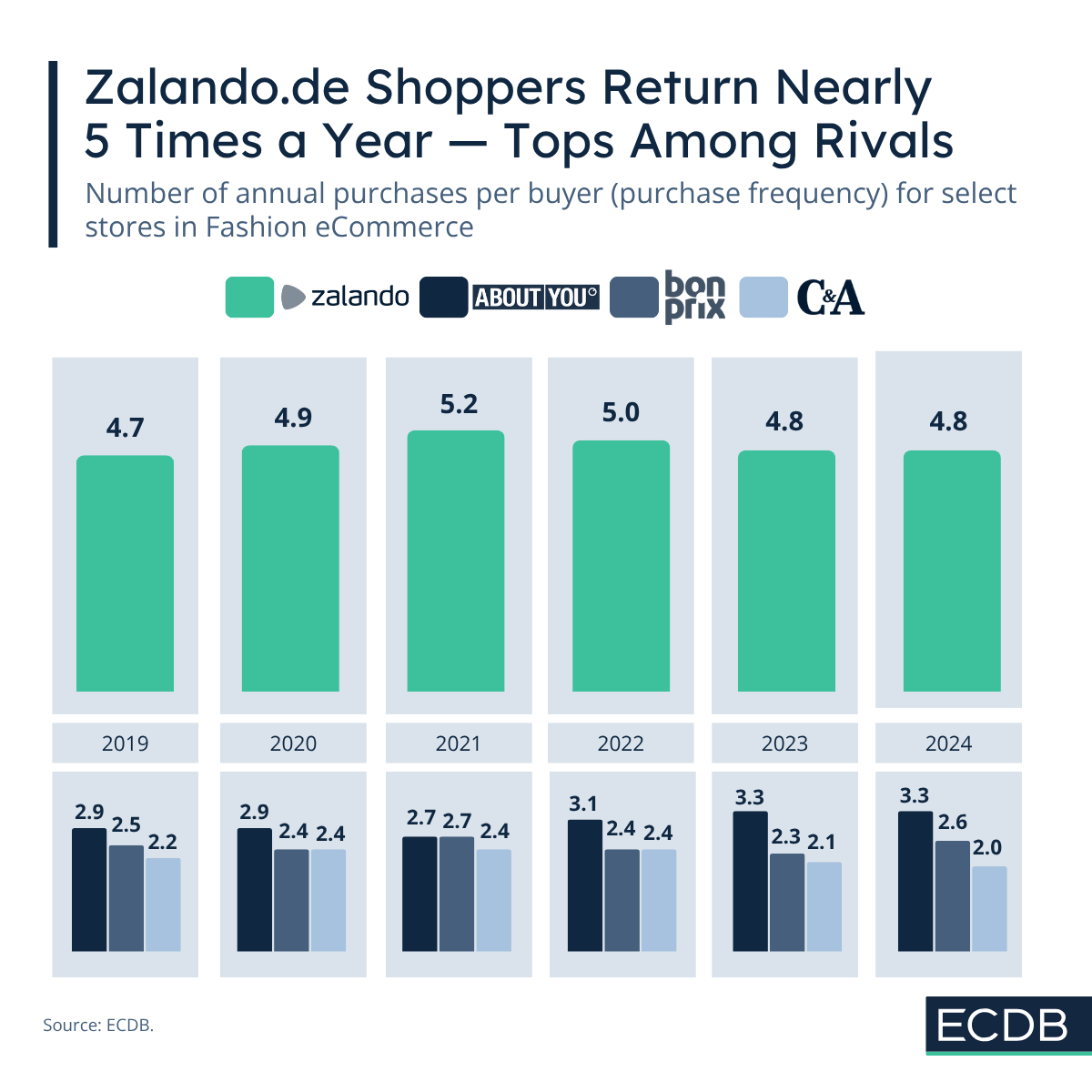Which Platforms Stood Out with High Number of Orders Growth in eCommerce
The ECDB Tool recently added the number of orders view. Here is what you can do with it and how a holistic analysis is all the more enhanced by including number of orders.
Transaction KPI Analysis
Consumers buy products nearly five times per year on zalando.de. Other home-grown platforms in the German market fall behind.

Nadine Koutsou-Wehling
Data Journalist
August 19, 2025
Transactions

Purchase frequency is an important indicator of customer loyalty and provides insight into retailer success beyond a single metric. While revenue analysis in eCommerce is instrumental in gauging retailer success, the important question is how that performance came to be.
One of the most insightful metrics to examine consumer behavior on a platform is purchase frequency. It measures how often a unique user buys products from a retailer in a year.
A high purchase frequency is a good sign, especially in fashion. It signals that users are satisfied with nonessential products. Unlike groceries, which need to be purchased multiple times a month, a high purchase frequency in fashion means that platforms are successfully building loyalty, inspiring repeat purchases, and staying top of mind.
Currently, Zalando's approved takeover of rival About You is making headlines. This acquisition will have ripple effects throughout Europe as the two fashion leaders merge and reach more consumers.
Zalando has always been the bigger platform, but About You has a stronger presence in Central and Eastern Europe. Zalando’s advantage is evident in its higher revenue, which is influenced by purchase frequency.
Zalando.de, Zalando’s strongest domain, shows the succession of purchase frequency. Zalando.de experienced ups and downs but maintained an average purchase frequency of around five times, peaking at 5.2 times in 2021.
Five times is a high value for fashion products. As mentioned in the introduction, fashion are nonessential items, with more of a leisurely character for users. At least when they are bought as frequently as they are at zalando.de.
In contrast, aboutyou.de has seen an increase in purchase frequency since 2019. On average, consumers buy from About You less frequently than from Zalando, but aboutyou.de maintains a decent position in the overall market.
More precisely, About You's purchase frequency rose from 2.9 times in 2019 to 3.3 times in 2024. Competition from Zalando and other platforms with lower prices and similar turnaround times held About You to a lower average purchase frequency. However, other factors should not be overlooked.
Apart from purely quantitative aspects, the user experience and different styles appealing to different consumer segments who are unwilling or unable to buy products more often should be considered.
Compared to similar stores in the market, however, aboutyou.de has a slight advantage. This illustrates how well Zalando performs, with a purchase frequency of almost five times. However, it also shows that consumers usually do not buy fashion products more than three times a year on average.
Other retailers in the market are on a downward trend; this affects especially homegrown German platforms such as retailer C&A (c-and-a.com) and Bonprix (bonprix.de). C&A experienced a decline in purchase frequency, dropping from a peak of 2.4 in 2020 to 2.0 in 2024.
Bonprix fared slightly better, with a fluctuating purchase frequency that has remained relatively stable since 2019. On average, consumers buy 2.5 times a year on bonprix.de, and the platform noted a frequency of 2.6 times in 2024.
Intensifying competition in the online fashion market contributes to the stagnant performance of second-tier retailers. Although platforms like Bonprix and C&A have loyal customer bases that support their core business, a large number of competing platforms make it increasingly difficult for them to stand out and motivate consumers to purchase fashion items more frequently.
Overall, purchase frequency is a metric that digs deeper into the why of revenue development. Aspects like website appeal, product quality and purchasing power of consumer segments reveal why some retailers thrive where others lag.
Related Articles
The ECDB Tool recently added the number of orders view. Here is what you can do with it and how a holistic analysis is all the more enhanced by including number of orders.
Although the German Fashion market has a low add-to-cart rate, the market is proving that it is possible to maintain a high conversion rate – how does it work?
Average order values in eCommerce vary, depending on which country is in focus. A comparison of the markets with the highest value shows Europe is taking a lead.

Click here for
more relevant insights from
our partner Mastercard.
Our Tool
We’re not just another blog—we’re an advanced eCommerce data analytics tool. The insights you find here are powered by real data from our platform, providing you with a fact-based perspective on market trends, store performance, industry developments, and more.
Analyze retailers in depth with our extensive Retailer dashboards and compare up to four retailers of your choice.
Learn More
Combine countries and categories of your choice and analyze markets in depth with our advanced market dashboards.
Learn More
Compile detailed rankings by category and country and fine-tune them with our advanced filter options.
Learn More
Discover relevant leads and contacts in your chosen markets, build lists, and download them effortlessly with a single click.
Learn More
Benchmark transactional and conversion funnel KPIs against market standards and gain insight into the key metrics of your relevant market.
Learn More
Our reports provide pre-analysed data and highlight key insights to help you quickly identify key trends.
Learn More
Find your perfect solution and let ECDB empower your eCommerce success.